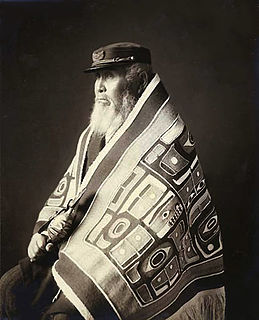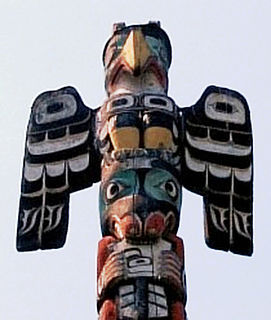
Totem poles are monumental carvings, a type of Northwest Coast art, consisting of poles, posts or pillars, carved with symbols or figures. They are usually made from large trees, mostly western red cedar, by First Nations and indigenous peoples of the Pacific Northwest coast including northern Northwest Coast Haida, Tlingit, and Tsimshian communities in Southeast Alaska and British Columbia, Kwakwaka'wakw and Nuu-chah-nulth communities in southern British Columbia, and the Coast Salish communities in Washington and British Columbia.

A potlatch is a gift-giving feast practiced by Indigenous peoples of the Pacific Northwest Coast of Canada and the United States, among whom it is traditionally the primary economic system. This includes the Heiltsuk, Haida, Nuxalk, Tlingit, Makah, Tsimshian, Nuu-chah-nulth, Kwakwaka'wakw, and Coast Salish cultures. Potlatches are also a common feature of the peoples of the Interior and of the Subarctic adjoining the Northwest Coast, though mostly without the elaborate ritual and gift-giving economy of the coastal peoples.

The Kwakwa̱ka̱ʼwakw, also known as the Kwakiutl are Indigenous peoples of the Pacific Northwest Coast. Their current population, according to a 2016 census, is 3,665. Most live in their traditional territory on northern Vancouver Island, nearby smaller islands including the Discovery Islands, and the adjacent British Columbia mainland. Some also live outside their homelands in urban areas such as Victoria and Vancouver. They are politically organized into 13 band governments.
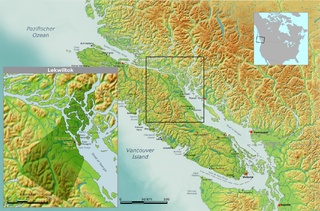
Laich-kwil-tach, is the Anglicization of the Kwak'wala autonomy by the "Southern Kwakiutl" people of Quadra Island and Campbell River in British Columbia, Canada. There are today two main groups : the Wei Wai Kai and Wei Wai Kum just across on the Vancouver Island "mainland" in the town of Campbell River. In addition to these two main groups there are the Kwiakah originally from Phillips Arm and Frederick Arm and the Discovery Islands, the Tlaaluis (Laa'luls) between Bute and Loughborough Inlets—after a great war between the Kwakiutl and the Salish peoples they were so reduced in numbers that they joined the Kwiakah—and the Walitsima / Walitsum Band of Salmon River.

Bill Holm is a U.S. artist, author and art historian specializing in the visual arts of Northwest Coast Native Americans as well as a practitioner and teacher of the Northwest Coast art style. He is Professor Emeritus of Art History, and Curator Emeritus of Northwest Coast Indian Art at the Burke Museum of Natural History and Culture and occasionally lectures at the University of Washington in Seattle.

Northwest Coast art is the term commonly applied to a style of art created primarily by artists from Tlingit, Haida, Heiltsuk, Nuxalk, Tsimshian, Kwakwaka'wakw, Nuu-chah-nulth and other First Nations and Native American tribes of the Northwest Coast of North America, from pre-European-contact times up to the present.
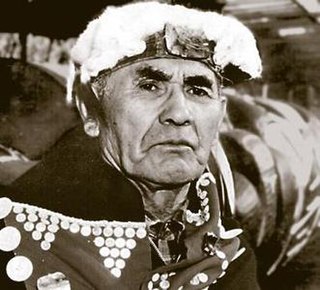
Chief Mungo Martin or Nakapenkem, Datsa, was an important figure in Northwest Coast style art, specifically that of the Kwakwaka'wakw Aboriginal people who live in the area of British Columbia and Vancouver Island. He was a major contributor to Kwakwaka'wakw art, especially in the realm of wood sculpture and painting. He was also known as a singer and songwriter.

Dzunuḵ̓wa, also Tsonoqua, Tsonokwa, Basket Ogress, is a figure in Kwakwaka'wakw mythology and Nuu-chah-nulth mythology.
Bakwas is one of the supernatural spirits of the Kwakwaka'wakw people of coastal British Columbia. He is often called "wild man of the woods." He eats ghost food out of cockle shells and tries to offer this to living humans who are stranded in the woods, in order to bring them over to the ghost world. If the human were to eat this food, it would turn them into a being like the bakwas. He lives in an invisible house in the forest and the spirits of the drowned congregate there. In some myths he is described as the consort of dzunukwa, and the father of her children.
Tlugwe, in the Kwak'wala language of the Kwakwaka'wakw people in British Columbia, means 'supernatural treasure'. Tlugwe are one of the most important features of Kwakwaka'wakw religious practices.
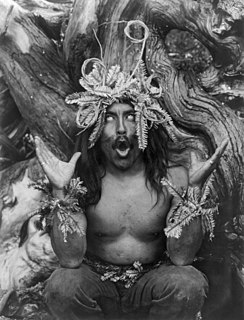
Hamatsa is the name of a Kwakwaka'wakw secret society. During the winter months the Kwakwaka'wakw of British Columbia have many ceremonies practiced by different secret societies. According to the German-American anthropologist Franz Boas, who studied the Kwakwaka'wakw tribe during the late 1880s, there were four main societies: The war society (Winalagalis), the magical society (Matem), the society of the afterlife (Bakwas) and the "cannibal" society (Hamatsa).
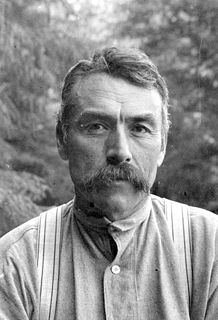
George Hunt (Tlingit) was a consultant to the American anthropologist Franz Boas; through his contributions he is considered a linguist and ethnologist in his own right. He was Tlingit-English by birth and learned both those languages. Growing up with his parents at Fort Rupert, British Columbia in Kwakwaka'wakw territory, he learned their language and culture as well. Through marriage and adoption he became an expert on the traditions of the Kwakwaka'wakw of coastal British Columbia.
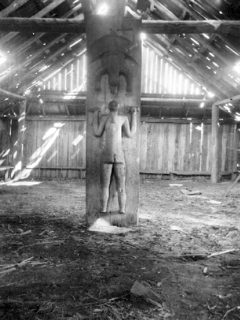
Coast Salish art is an art unique to the Pacific Northwest Coast among the Coast Salish peoples. Coast Salish are peoples from the Pacific Northwest Coast made up of many different languages and cultural characteristics. Coast Salish territory covers the coast of British Columbia and Washington state. Within traditional Coast Salish art there are two major forms; the flat design and carving, and basketry and weaving. In historical times these were delineated among male and female roles in the community with men made "figurative pieces, such as sculptures and paintings that depicts crest, shamanic beings, and spirits, whereas women produced baskets and textiles, most often decorated with abstract designs."
Willie Seaweed (1873–1967) was a Kwakwaka'wakw chief and wood carver from Canada. He was considered a master Northwest Coast Indian artist who is remembered for his technical artistic style and protection of traditional native ceremonies during the Canadian potlatch ceremony ban. Today, Seaweed's work can be found in cultural centers and corporations, art museums, natural history museums, and private collections. Some pieces are still in use by the Nak'waxda'xw tribe.

Kwakwaka'wakw art describes the art of the Kwakwaka'wakw peoples of British Columbia. It encompasses a wide variety of woodcarving, sculpture, painting, weaving and dance. Kwakwaka'wakw arts are exemplified in totem poles, masks, wooden carvings, jewelry and woven blankets. Visual arts are defined by simplicity, realism, and artistic emphasis. Dances are observed in the many rituals and ceremonies in Kwakwaka'wakw culture. Much of what is known about Kwakwaka'wakw art comes from oral history, archeological finds in the 19th century, inherited objects, and devoted artists educated in Kwakwaka'wakw traditions.

Dantsikw are dance props of the first nations Kwakwaka'wakwa people of British Columbia, Canada. These boards were employed in during the Winter Ceremonials (Tseka). In the Tuxwid warrior ceremony, the initiates would demonstrate supernatural powers granted by Winalagilis by summoning Dantsikw power boards from underground, and making them disappear again. This act commemorates Winalagalis' supernatural canoe that could travel underground.

Winalagalis is a war god of the Kwakwaka'wakw native people of British Columbia. He travels the world, making war. Winalagilis comes from North (underworld) to winter with the Kwakwaka'wakw. Winalagalis is the bringer and ruler of Tseka, and imbues red cedar bark with supernatural power.
Kwakwaka'wakw music is a sacred and ancient art of the Kwakwaka'wakw peoples that has been practiced for thousands of years. The Kwakwaka'wakw are a collective of twenty-five nations of the Wakashan language family who altogether form part of a larger identity comprising the Indigenous Peoples of the Pacific Northwest Coast, located in what is known today as British Columbia, Canada.

